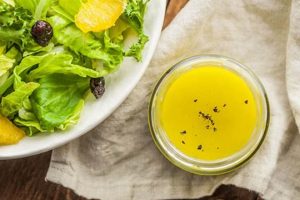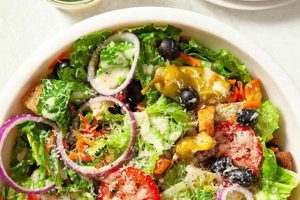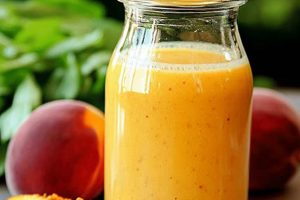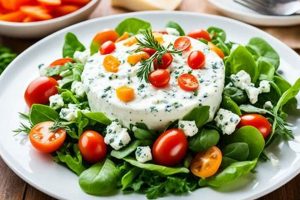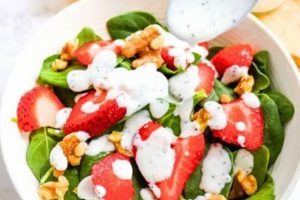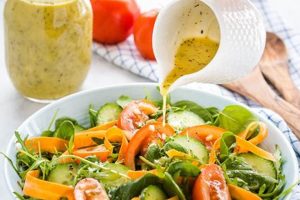A guide to creating a flavorful condiment for salads typically involves a blend of oil, acid (like vinegar or citrus juice), and the distinctive pungent warmth of ginger. This culinary creation can range from simple mixtures to more complex emulsions, often incorporating additional ingredients such as soy sauce, honey, garlic, or other spices to achieve diverse flavor profiles. Examples include a light vinaigrette featuring grated fresh ginger, rice vinegar, and sesame oil, or a creamy dressing based on Greek yogurt, ginger, and lime juice.
Such condiments offer a vibrant and refreshing counterpoint to the other salad components. The ginger not only contributes a unique flavor but also potential health benefits, as it’s known for its anti-inflammatory properties. Historically, ginger has played a significant role in various cuisines, both for its culinary and medicinal value, further enriching the cultural context of its inclusion in dressings. The rising interest in healthy eating and global flavors contributes to the contemporary popularity of these dressings.
This exploration will delve further into various ginger dressing preparation methods, ingredient variations, nutritional aspects, and culinary applications.
Tips for Crafting Exceptional Ginger Salad Dressings
The following tips offer guidance for maximizing flavor and versatility when preparing ginger-based salad dressings.
Tip 1: Balance is Key: Strive for a harmonious blend of sweet, sour, salty, and spicy elements. Taste and adjust seasonings throughout the preparation process to achieve the desired balance. For example, if a dressing is too tart, a touch of honey or maple syrup can restore equilibrium.
Tip 2: Fresh Ginger vs. Ground Ginger: Fresh ginger offers a brighter, more pronounced flavor, while ground ginger provides a subtle warmth. The choice depends on the desired intensity and overall flavor profile. A vinaigrette may benefit from the vibrancy of fresh ginger, while a creamy dressing might prefer the earthiness of ground ginger.
Tip 3: Proper Ginger Preparation: For fresh ginger, peeling is essential. Finely grating or mincing ensures even distribution of flavor throughout the dressing. Consider using a microplane or fine grater for optimal results.
Tip 4: Oil Selection: The type of oil influences the dressing’s overall taste and texture. Neutral oils like grapeseed or canola allow the ginger flavor to shine. Sesame oil adds a nutty dimension, while olive oil lends a robust, peppery note.
Tip 5: Emulsification Techniques: For creamy dressings, proper emulsification creates a stable and smooth texture. Whisking ingredients vigorously or using a blender helps prevent separation and ensures a cohesive consistency.
Tip 6: Storage and Serving: Store dressings in airtight containers in the refrigerator for optimal freshness. Allow the dressing to come to room temperature before serving to enhance the flavors and aroma.
Tip 7: Experiment with Flavor Combinations: Don’t be afraid to explore different flavor combinations. Ginger pairs well with ingredients like garlic, lime, soy sauce, cilantro, and chili flakes, offering endless possibilities for culinary creativity.
By considering these tips, one can consistently produce high-quality ginger dressings that elevate any salad.
This exploration concludes with a summary of key findings and a look towards future culinary innovations.
1. Ingredients
Ingredient selection is paramount in crafting a successful ginger salad dressing. The quality, freshness, and balance of ingredients directly impact the final flavor profile, texture, and overall culinary experience. Understanding the role of each component is essential for achieving the desired outcome.
- Ginger:
The cornerstone of the dressing, ginger provides the signature pungent warmth. Fresh ginger offers a brighter, more pronounced flavor, while ground ginger delivers a mellower, earthier taste. The form chosen influences preparation methods and the overall intensity of the ginger flavor. For instance, fresh ginger requires grating or mincing, whereas ground ginger can be directly incorporated into the dressing.
- Acidic Component:
Acidity balances the sweetness and richness of other ingredients. Common choices include rice vinegar, apple cider vinegar, lime juice, or lemon juice. Each acid imparts unique flavor nuances, impacting the final taste profile. For example, rice vinegar contributes a mild sweetness, while lime juice provides a zesty tang. The acidity level also influences the dressing’s emulsifying properties and its interaction with other components.
- Oil:
Oil provides body, texture, and carries flavor compounds. Neutral oils, such as grapeseed or canola, allow other ingredients to shine, while oils like sesame or olive impart their own distinct flavors. The oil’s viscosity affects the dressing’s mouthfeel and how it coats salad ingredients. For instance, a light sesame oil contributes a nutty taste and a delicate texture, while a robust extra virgin olive oil offers a peppery note and a richer mouthfeel.
- Sweetener (Optional):
Sweeteners balance acidity and enhance complexity. Options include honey, maple syrup, or sugar. The choice of sweetener influences the dressing’s sweetness level and overall flavor profile. Honey, for instance, adds floral notes, while maple syrup offers a subtle caramel undertone. The amount used determines the balance between sweet, sour, and savory elements.
The interplay of these core ingredients defines the character of the ginger salad dressing. Harmonious balance between the ginger’s pungency, the acid’s tartness, the oil’s richness, and the optional sweetness is key to a successful recipe. Thoughtful selection and proportioning of ingredients allows for a wide range of flavor profiles, from bright and zesty to rich and savory.
2. Proportions
Precise ingredient ratios significantly influence the balance and overall success of a ginger salad dressing. Understanding the interplay between components is crucial for achieving the desired flavor profile and texture. Proportions dictate the dominance of individual flavors, the emulsification process, and the final consistency of the dressing.
- Oil to Acid Ratio:
The ratio of oil to acid is fundamental to a balanced dressing. A higher oil content creates a richer, more viscous dressing, while a higher acid content results in a sharper, thinner consistency. A typical starting point is a 3:1 ratio of oil to acid, but this can be adjusted based on personal preference and the specific ingredients used. For example, a lighter vinaigrette might employ a 2:1 ratio, while a creamier dressing could benefit from a 4:1 ratio. The balance between these two components affects not only the taste but also the emulsification stability and the way the dressing coats salad ingredients.
- Ginger Concentration:
The amount of ginger determines the intensity of its flavor within the dressing. Too much ginger can overpower other ingredients, while too little might render it undetectable. The ideal amount depends on the type of ginger used (fresh or ground) and the desired level of pungency. A general guideline is to start with a smaller amount and adjust to taste. For instance, a tablespoon of freshly grated ginger might suffice for a vinaigrette, whereas a teaspoon of ground ginger could be appropriate for a creamy dressing. Careful adjustment of the ginger proportion ensures a harmonious balance of flavors.
- Sweetener Level:
When incorporating a sweetener, its proportion relative to other ingredients is crucial. Over-sweetening can mask the nuanced flavors of the ginger and acid, while insufficient sweetness can leave the dressing unbalanced. The ideal sweetness level depends on personal preference and the specific sweetener used. Starting with a small amount and adjusting incrementally allows for precise control over the final sweetness. A teaspoon of honey or maple syrup is often a good starting point, allowing for adjustments based on the overall flavor profile being sought.
- Additional Flavorings:
If incorporating additional ingredients such as garlic, soy sauce, or chili flakes, their proportions must be carefully considered. These additions should complement, not overpower, the core flavors of the dressing. A small amount of garlic or a dash of soy sauce can add depth and complexity without overwhelming the ginger. Starting with conservative amounts and adjusting incrementally allows for optimal integration of these secondary flavors.
Careful consideration of these proportions ensures a harmonious and balanced ginger salad dressing. The interplay of oil, acid, ginger, sweetener, and additional flavorings ultimately determines the final flavor profile, texture, and overall appeal of the dressing. Experimentation and incremental adjustments are key to achieving the perfect balance for individual preferences and culinary applications.
3. Preparation Method
Preparation methods significantly influence the final flavor profile, texture, and emulsification stability of ginger salad dressings. Distinct techniques yield varied results, impacting how ingredients combine and interact. The chosen method dictates the level of ginger integration, the smoothness of the dressing, and the overall sensory experience.
For dressings utilizing fresh ginger, the preparation typically begins with peeling and finely mincing or grating the ginger. This maximizes surface area, allowing for greater flavor release and even distribution within the dressing. Conversely, ground ginger can be directly incorporated, requiring less preparation. The order of ingredient addition also impacts the outcome. For example, emulsified dressings often benefit from gradually whisking the oil into the acid, creating a stable and cohesive mixture. Alternatively, blending all ingredients simultaneously produces a smooth and homogenous dressing, particularly effective for creamy variations.
Consider a vinaigrette featuring fresh ginger, rice vinegar, and sesame oil. Mincing the ginger finely before combining it with the vinegar allows the acidic component to extract maximum flavor. Slowly whisking in the sesame oil while constantly agitating the mixture creates a temporary emulsion, resulting in a light and vibrant dressing. In contrast, a creamy dressing based on Greek yogurt, ground ginger, and lime juice benefits from blending all ingredients together until perfectly smooth. This method ensures even distribution of the ground ginger and a homogenous texture.
Different methods cater to distinct flavor profiles and desired textures. A coarse chop of fresh ginger in a vinaigrette offers bursts of intense flavor, while finely grated ginger provides a more subtle, consistent presence. The choice between whisking and blending influences the final smoothness and emulsification stability. Understanding the nuances of each preparation method allows for precise control over the final product, ensuring the dressing perfectly complements the intended culinary application.
4. Flavor Profile
Flavor profile constitutes a critical element within the development and execution of a ginger salad dressing recipe. A well-defined flavor profile guides ingredient selection, proportioning, and preparation methods, ultimately shaping the sensory experience of the final product. This profile encompasses the complex interplay of sweet, sour, salty, spicy, and umami notes, creating a harmonious and balanced taste sensation. Understanding this interplay is essential for crafting a successful dressing.
Specific ingredients contribute distinct characteristics to the overall flavor profile. The pungency of ginger, the acidity of vinegar or citrus juice, the richness of oil, and the potential addition of sweeteners or other spices all interact to create a complex tapestry of taste. For example, a dressing featuring fresh ginger, lime juice, and honey will offer a bright, zesty flavor profile with a touch of sweetness. Conversely, a dressing based on ground ginger, rice vinegar, and soy sauce delivers a more savory, umami-rich profile with subtle earthy notes. Manipulating ingredient ratios further refines the flavor profile, allowing for customization based on desired outcomes and culinary applications. Increasing the proportion of lime juice accentuates tartness, while adding more honey amplifies sweetness. These adjustments allow for precise tailoring of the flavor experience.
Achieving a desirable flavor profile necessitates careful consideration of the target audience and the intended use of the dressing. A light and tangy ginger dressing complements delicate greens and vegetables, while a richer, more robust dressing enhances heartier salads or grilled proteins. Understanding the interplay of flavors and how they interact with different ingredients is crucial for maximizing culinary impact. Challenges may arise from ingredient availability, dietary restrictions, or personal preferences, requiring creative solutions and adaptable recipes. Ultimately, a well-crafted flavor profile elevates the ginger salad dressing from a simple condiment to an integral component of a complete culinary experience.
5. Storage
Proper storage is crucial for maintaining the quality, flavor, and safety of ginger salad dressings. Improper storage can lead to undesirable changes in texture, flavor degradation, and potential microbial growth. Factors such as temperature, exposure to air and light, and container type significantly influence the shelf life and overall quality of the dressing. Understanding these factors allows for optimized storage practices that preserve the intended flavor profile and ensure food safety.
Ginger dressings containing fresh ingredients are generally more susceptible to spoilage than those made with shelf-stable components. Refrigeration is essential for these dressings, ideally stored in airtight containers to minimize oxidation and microbial contamination. Exposure to air can cause oils to become rancid and flavors to dull, while light exposure can degrade certain vitamins and pigments. Glass containers are preferred over plastic, as they are less likely to leach chemicals or absorb odors. A general guideline for refrigerated storage is up to one week, though specific ingredients and preparation methods can influence this timeframe. For example, dressings containing dairy or fresh herbs may have a shorter shelf life.
Dressings primarily composed of shelf-stable ingredients, such as oil, vinegar, and spices, may have a longer shelf life at room temperature, especially in a cool, dark environment. However, refrigeration is still recommended to maintain optimal flavor and freshness. Freezing is generally not recommended for ginger salad dressings, as the emulsion can break upon thawing, leading to an undesirable texture. Proper labeling with preparation date facilitates effective stock rotation and helps prevent the consumption of spoiled dressings. Careful attention to storage practices ensures the longevity and quality of ginger salad dressings, maximizing their culinary potential and minimizing food waste.
6. Applications
The application of a ginger salad dressing extends beyond simply drizzling it over a bed of lettuce. A well-crafted ginger dressing possesses versatility, enhancing a wide array of dishes and culinary creations. Understanding the flavor profile of the dressing and its compatibility with various ingredients unlocks its full culinary potential. Consider the interplay of sweet, sour, spicy, and savory notes within the dressing and how they interact with different food textures and flavors. This understanding allows for creative and effective application across diverse culinary contexts.
Classic applications include salads featuring leafy greens, vegetables, fruits, nuts, and proteins. A light and tangy ginger dressing complements delicate greens and vegetables, while a richer, more robust dressing enhances heartier salads featuring roasted vegetables or grilled meats. Beyond salads, ginger dressings function as marinades for poultry, fish, or tofu, imparting flavor and tenderizing the protein. They can also serve as dipping sauces for spring rolls, dumplings, or grilled vegetables, adding a vibrant and refreshing element. Incorporating the dressing into grain bowls or noodle dishes adds a flavorful dimension, uniting diverse ingredients into a cohesive culinary experience. For instance, a ginger-lime dressing complements a quinoa bowl with grilled chicken and black beans, while a ginger-soy dressing enhances a cold noodle salad with shredded vegetables and tofu.
Effective application requires careful consideration of the dressing’s flavor profile and the other components of the dish. A ginger dressing with strong citrus notes might overpower delicate fish, while a sweeter ginger dressing might clash with savory grilled meats. Understanding these nuances allows for strategic pairings that maximize flavor synergy and create a balanced and harmonious culinary experience. Challenges may arise from balancing the intensity of the ginger flavor with other dominant ingredients or accommodating dietary restrictions, necessitating adaptable recipes and creative application strategies. Successful integration of ginger salad dressings across diverse culinary applications enhances flavor complexity, adds textural interest, and elevates the overall dining experience.
Frequently Asked Questions
This section addresses common inquiries regarding the preparation, storage, and utilization of ginger salad dressings.
Question 1: How long can a ginger salad dressing be stored in the refrigerator?
Refrigerated storage in an airtight container typically allows for optimal quality for up to one week. Dressings containing fresh ingredients, particularly dairy or herbs, may have a shorter shelf life.
Question 2: Can ginger salad dressing be frozen?
Freezing is generally not recommended. The emulsion can break upon thawing, resulting in a separated and undesirable texture.
Question 3: What type of oil is best suited for ginger salad dressing?
Neutral oils like grapeseed or canola allow the ginger flavor to shine. Sesame oil imparts a nutty flavor, while olive oil contributes a peppery note. The choice depends on the desired flavor profile.
Question 4: What can be done if a ginger dressing is too tart?
A touch of sweetness can balance excessive tartness. Small increments of honey, maple syrup, or sugar can be added until the desired balance is achieved.
Question 5: Can ginger salad dressing be used for purposes other than salads?
Absolutely. Ginger dressings can serve as marinades for proteins, dipping sauces for appetizers, or flavorful additions to grain bowls and noodle dishes.
Question 6: What is the difference between using fresh ginger and ground ginger in a dressing?
Fresh ginger provides a brighter, more pronounced flavor, while ground ginger offers a subtler, earthier taste. Preparation methods differ as well, with fresh ginger requiring mincing or grating.
Careful consideration of these frequently asked questions empowers individuals to create, store, and utilize ginger salad dressings effectively, maximizing flavor and culinary potential.
This concludes the exploration of ginger salad dressings. Further culinary experimentation and exploration are encouraged.
Conclusion
Exploration of recipes for ginger salad dressing reveals a multifaceted culinary topic. Careful consideration of ingredient selection, proportioning, and preparation methods is essential for crafting dressings that exhibit balanced flavor profiles and desirable textures. Fresh ginger offers a vibrant pungency, while ground ginger provides a subtle warmth. The interplay of oil, acid, and sweetener contributes to the overall balance and complexity. Proper storage maintains quality and extends shelf life. Application extends beyond salads, encompassing marinades, dipping sauces, and flavor enhancements for various dishes. Understanding these elements allows for informed choices and successful culinary outcomes.
Ginger’s historical and cultural significance, coupled with its potential health benefits, further elevates its culinary value. Continued exploration of flavor combinations and innovative applications promises exciting advancements within the realm of ginger-based condiments. Culinary experimentation is encouraged, fostering creativity and broadening gastronomic horizons.

